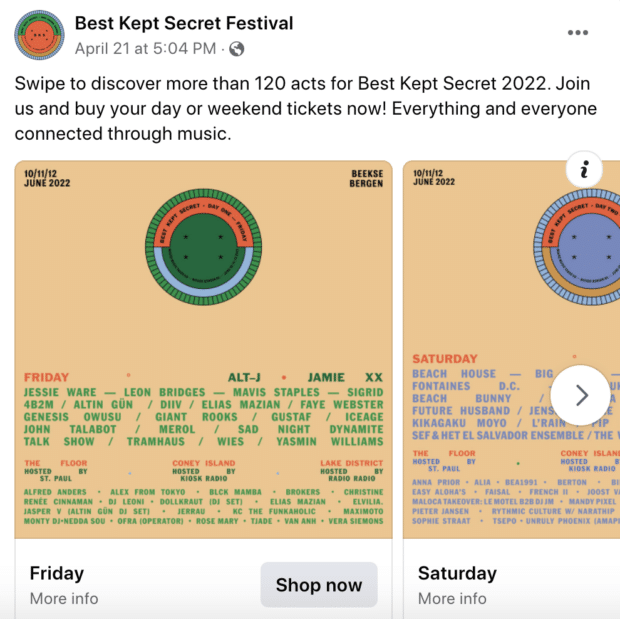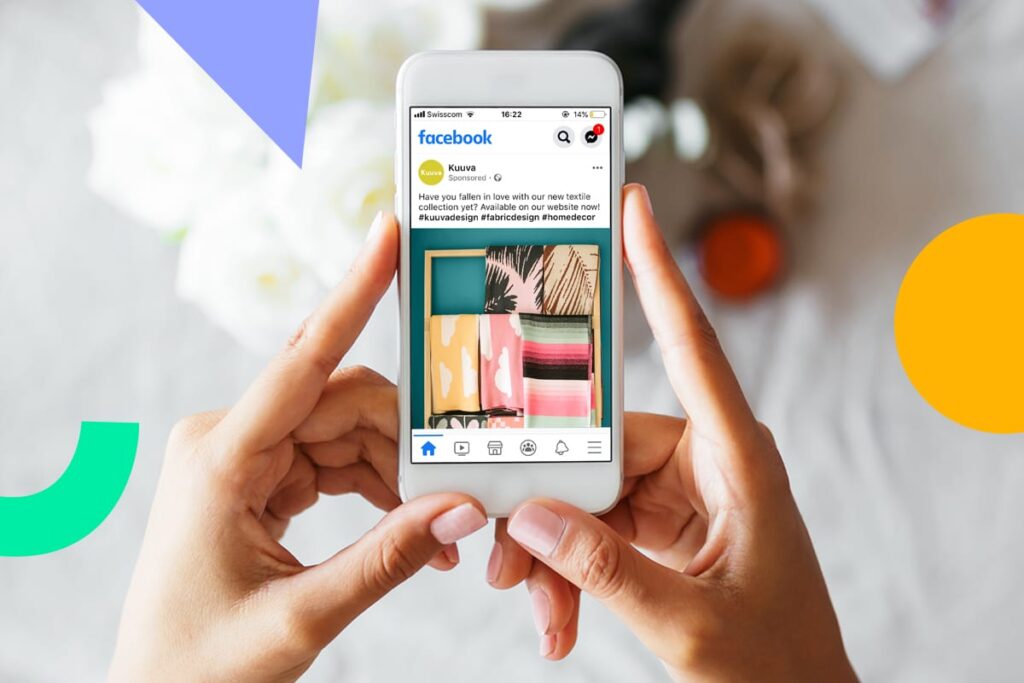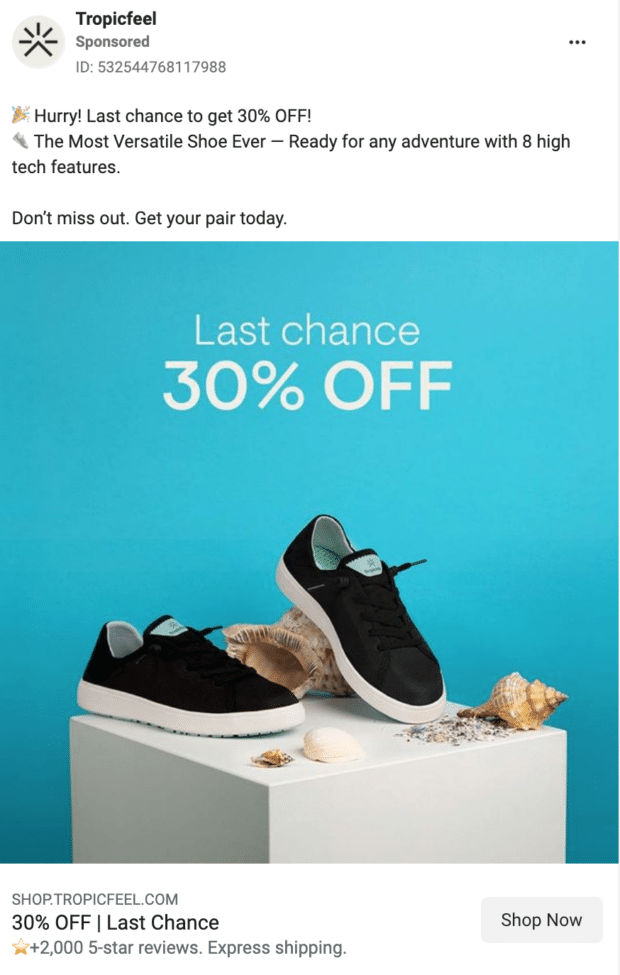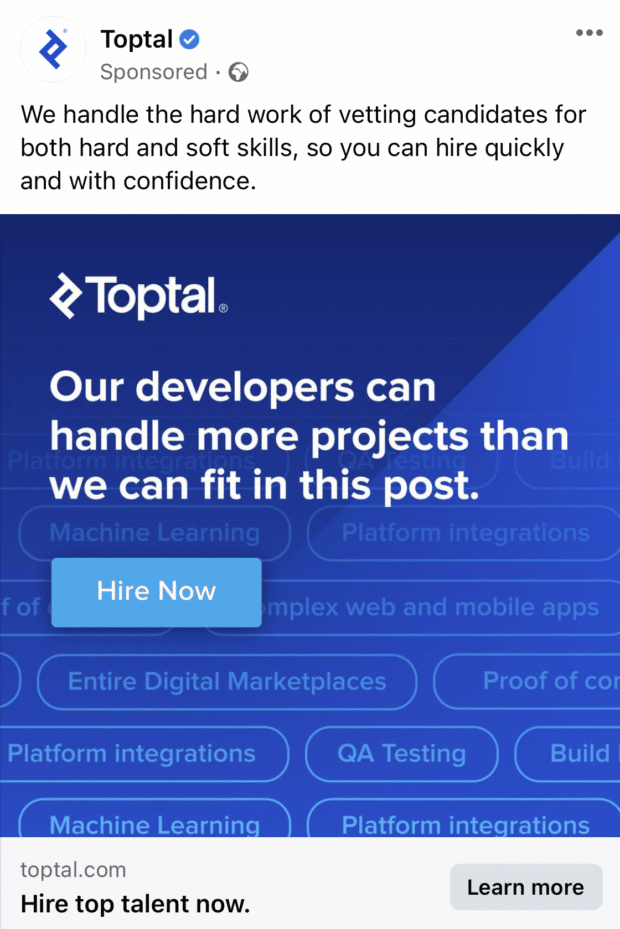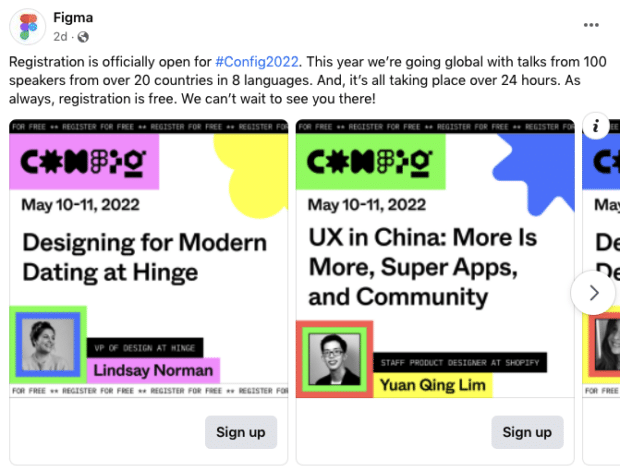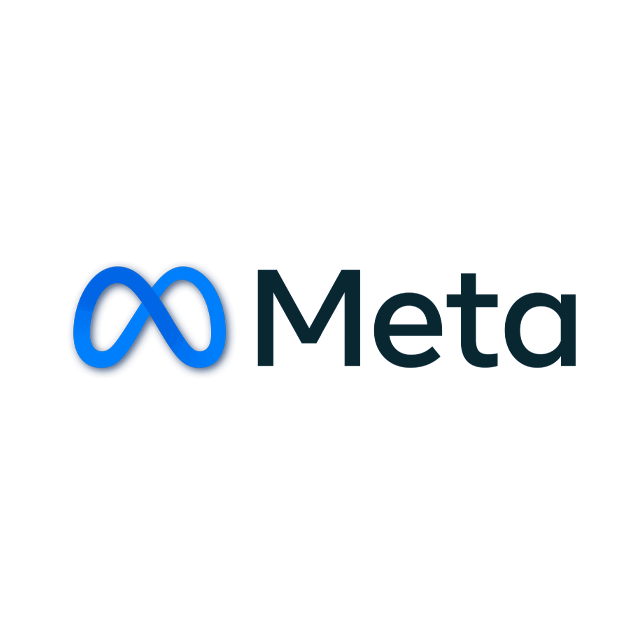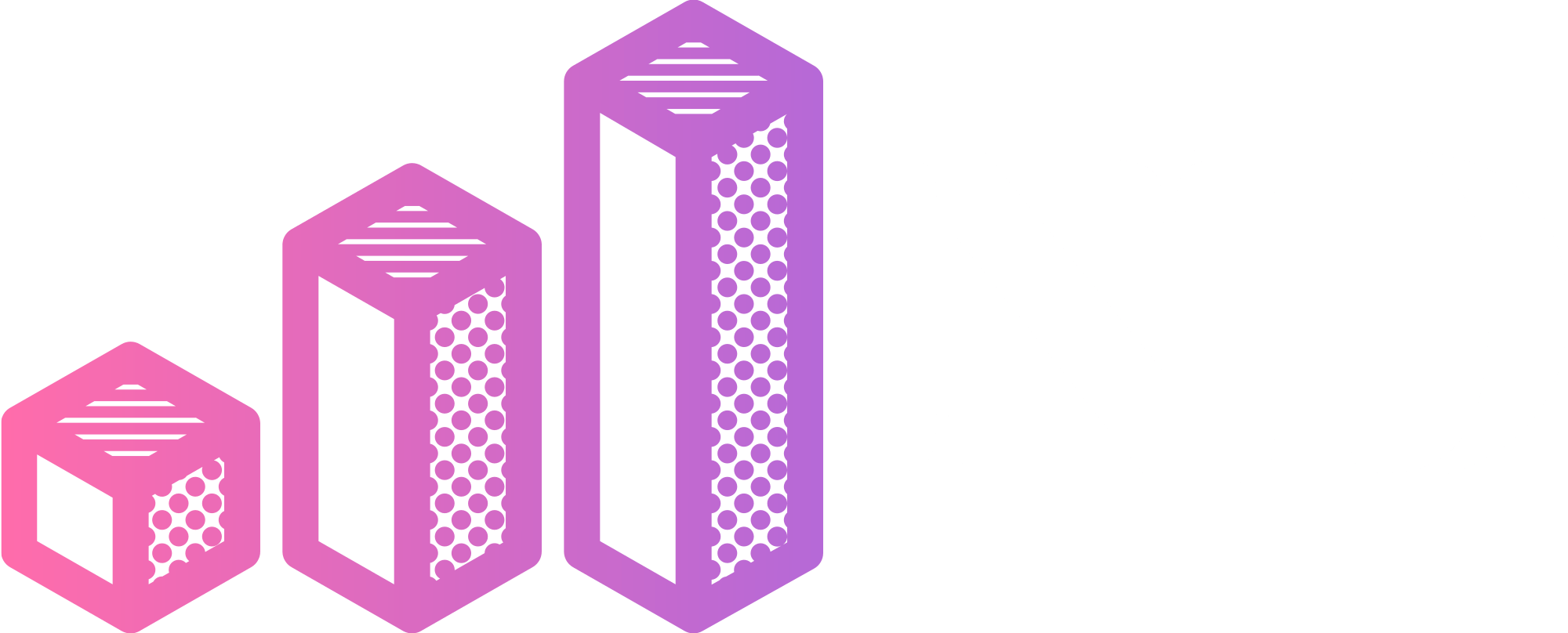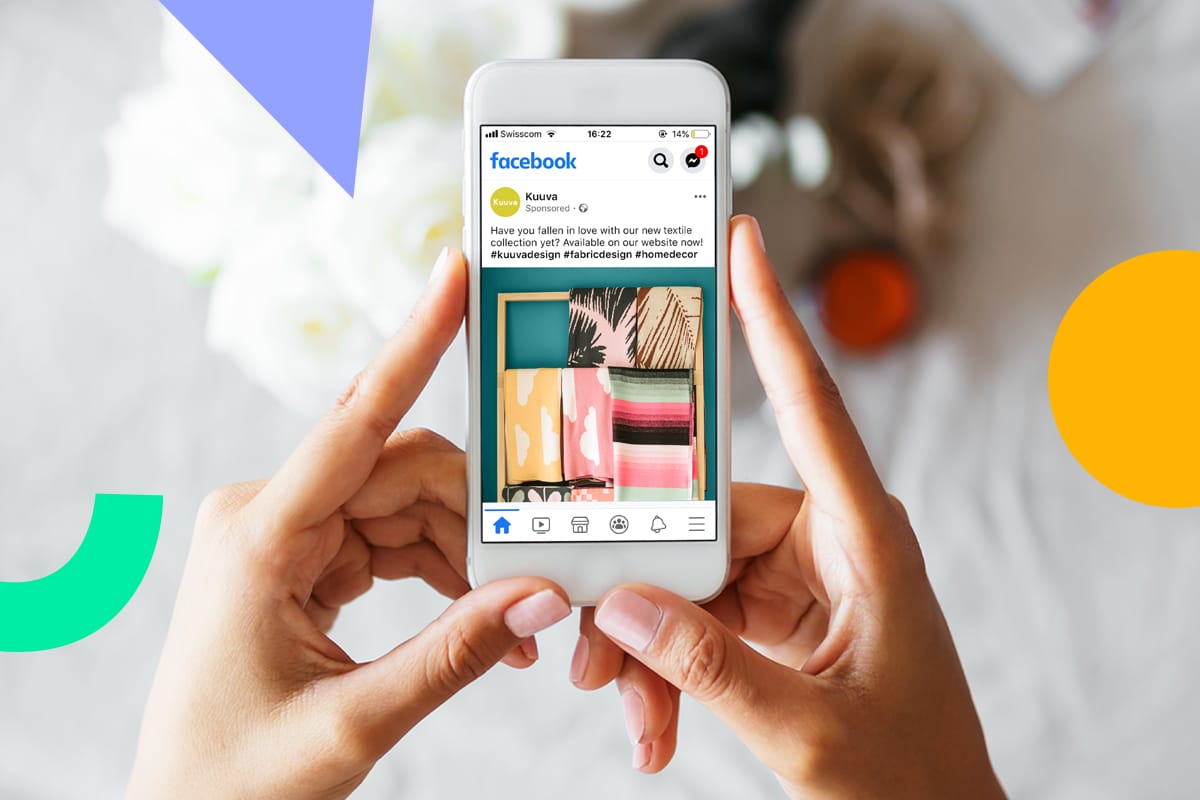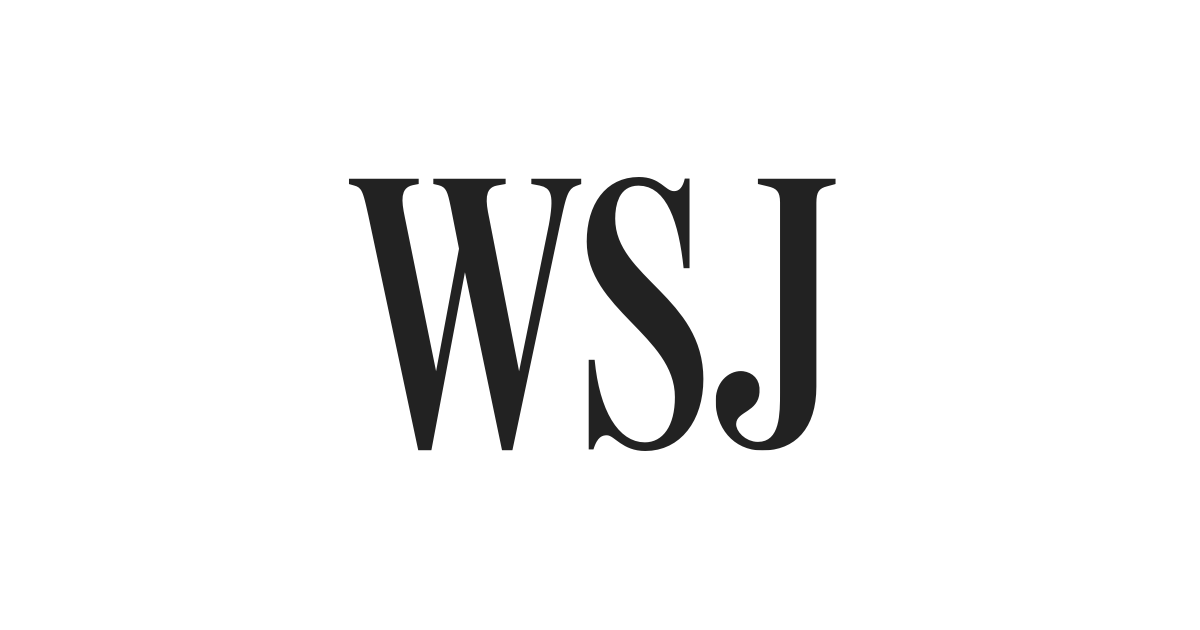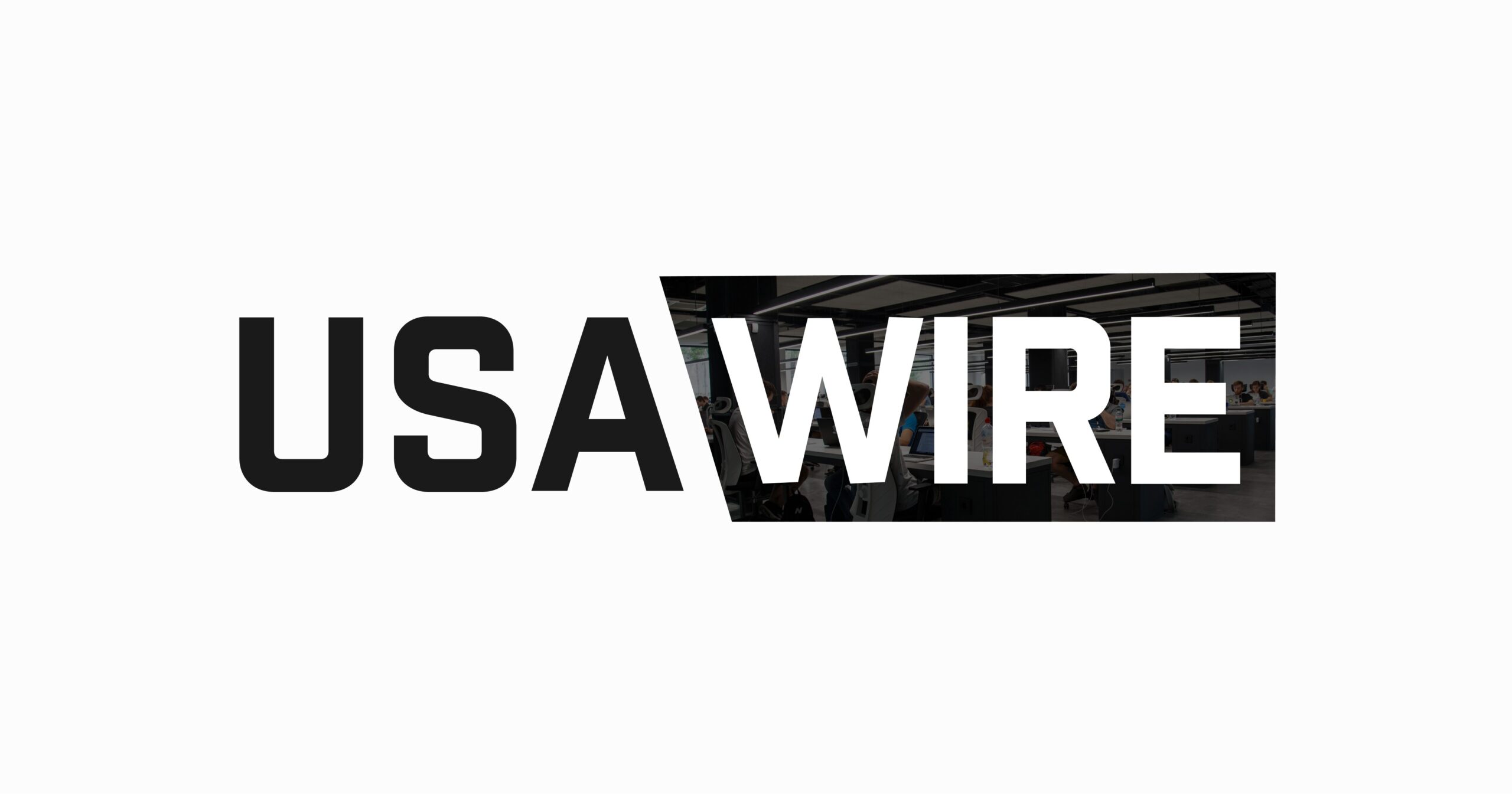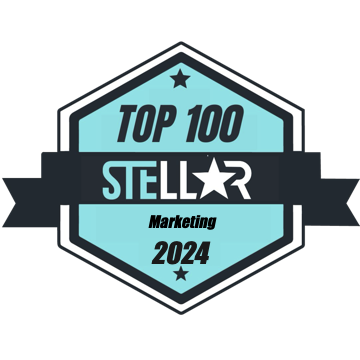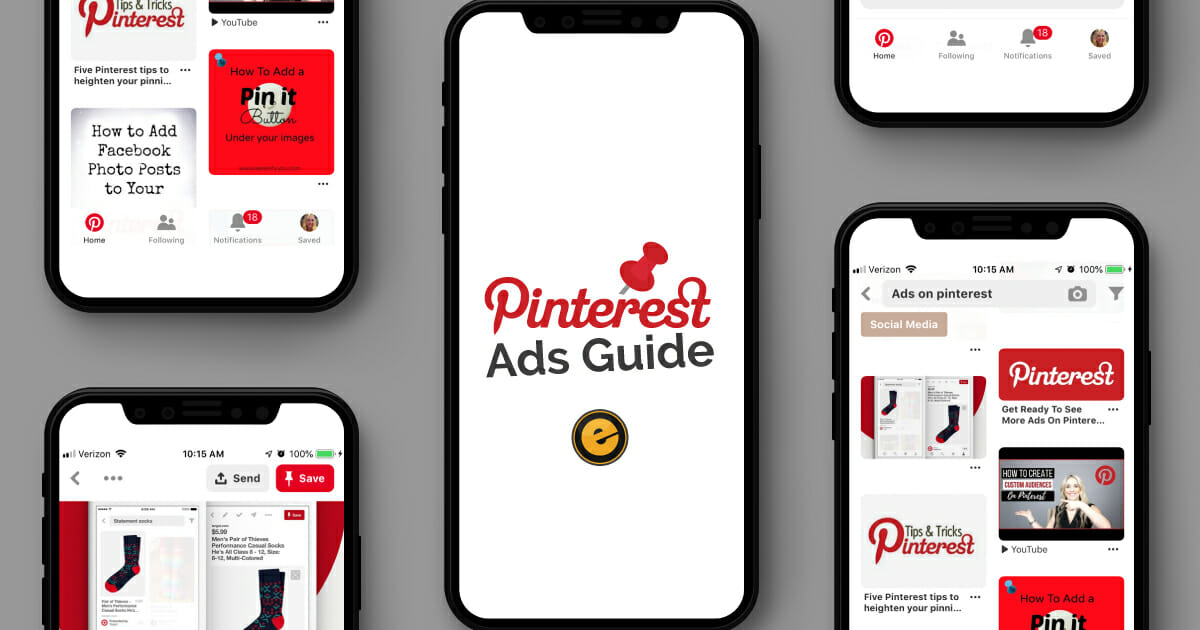How to Run Facebook Ads Step by Step in 2024
Introduction
Learning how to run Facebook ads in 2024 can be a game-changer for business owners and entrepreneurs. With the ever-evolving landscape of social media advertising, staying ahead of the curve is essential to reaching your target audience effectively.
If you’d like to learn more about Facebook’s usage worldwide, check out Adspresso’s article here.
Statista also released a great article on the number of Facebook’s daily active users worldwide in Q4 2023.
In this blog post, we will dive into the latest strategies and tips to help you maximize the potential of your Facebook ads campaign this year. So, buckle up and get ready to take your advertising game to the next level!
We also offer a more in-depth 130+ page guide on running Facebook Ads. If you’d like access to it or to work with us, please reach out to us!
First Step in Learning How to Run Facebook Ads
1. Your Business Requirements
One more thing before we go any further:
It’s imperative to determine if Facebook Ads is right for your business.
For most businesses, the answer is yes. But there’s a catch. It takes time to build, launch, and optimize campaigns—and ultimately, see results.
That means you need to have realistic expectations. Here are seven quick questions to consider first:
1. Are you ready to commit? It typically takes about 90 days to determine if there’s potential for a predictable, scalable growth schedule.
2. Can you afford the cost to get the ball rolling? You’ll want to spend at least $1,000-$1,500 per month at the bare minimum; but we recommend starting at a $2,000 minimum.
3. What are your business goals? Ask yourself:
- Do I know my close rates?
- Do I know how many leads I need to make a sale?
- Do I know how many leads each month I need to make a profit?
By establishing your specific goals, you can determine if you can successfully run a Facebook Ads campaign in the long-term.
4. How is the quality and speed of your website? We recommend your website is:
- Fast
- Mobile responsive
- Informative
- Easy to use
You can test your website using Page Speed Insights.
5. Can you handle an influx of traffic?
- Are you going to answer your phone when customers call?
- Will people call you directly, or will you have a sales team that’s trained and ready to take calls?
- Are you fully stocked and ready to ship?
- Can you accurately forecast how much product you need?
6. What is your audience size and location? If you’re local and rural—with only a handful of people nearby—your audience size might be too small. In this case, Facebook Ads probably doesn’t make sense for your business.
7. Are you ready to be competitive? Make sure your ad spend is competitive enough to make sure you get enough impressions and clicks. Otherwise, Facebook Ads won’t work in your favor.
1.1 Creating a Facebook Business Page
To advertise on Facebook, you have to have a Facebook Business Page and an Ad Account inside Facebook Business Manager. This is where you assign permissions, organizes their assets, manages audiences, and accesses all the reporting features.
- Personal Facebook Account > Pages > Create a page > Page Category > Business or Brand or Community or Public Figure
- Name the page the same as your business
- Add category
- After page is created, personalize it by adding profile photo and another for the cover photo. Make sure profile photo still looks good when cropped into a circle. It should be 170×170 pixels in size. Cover photo should be 851 pixels wide by 315 pixels tall. Sites like Canva.com have free templates to help get these the right size
- Edit Page Info to fill out as many details as you can about your page
- Choose About in left-hand column and fill in as much as you can of those details. Remember that you’re filling them out for a prospective client to read
1.2 Facebook Business Manager Setup
Then move onto creating a Business Manager account, where you organize and manage business-related activity
- Do this at business.facebook.com
- Click Create Account
- Enter name, business email address, address info, and more
- Once it is created, add your Business Page and then add/create your Ad account
- If you’re not sure you have an Ad Account, you can go to facebook.com/adsmanager/manage
- See if any accounts show up
- If they show up in the dropdown of accounts, click on them and copy the ID out of the address bar after the “act=#” in the URL
- If you need to create a new Ad account, you’ll need to name it such as your business name or page name
- Choose time zone and payment currency, and make sure the prefilled versions are correct. Can’t change them after
- Choose if you’re adding Ad account for yourself or for another business – choose the right option because if you choose another business, you gain access to their Audience Manager which is an important tool to choose who you show ads to
- Add anyone you’d like to have access to your page or ad account (Employee access is default). Always a good idea to have an additional admin on your account in case you get locked out. Can also assign a finance analyst role to see or edit billing info
- Once Page and Ad account are set up, update your business settings by clicking on gear symbol in top right corner. Link your Instagram account if you have one (Accounts on the left > Instagram accounts > Login > Choose Ad Account)
- Choose Payments on the left and add a credit card
- Click on Business Info near bottom of list and verify that all settings are correct
1.3 Facebook Pixel Setup
The Facebook Pixel is the New Way to Build a List
It is the first thing you do after setting up an Ad account. Likes to Facebook Business Pages used to the primary method, but now are no longer necessary.
Pixels are little bits of code on the websites you visit that set a cookie to uniquely tag you. Major players like Google and Facebook can associate the pixel cookie to a website visitor’s identity because they are logged into the Facebook or Google ecosystem. You’ll need to install these on your website.
It’s much better to pixel visitors to track and react to a person’s behavior. The pixel sends data to Facebook about all of your visitors that FB matches to your users. It allows you to:
- Optimize Targeting
- Once FB knows which people convert after clicking, it can start showing your ad to similar people to the converters rather than just the ad clickers if optimizing for an event
- Gain Insights About Website Visitors
- You can learn about their demographics (age,location, language, gender, lifestyle, education, relationship status, job role, etc.)
- How often they login to FB
- The top few pages people like
- Past purchase behavior
- Build retargeting audiences
- Based on people who visited a page or multiple pages on your website
- A more advanced approach is segmenting website visitors into multiple audiences based on events or specific pages they visit on your website (individual product pages, blog posts, checkout pages, etc.)
- For instance, someone who clicked Add To Cart is more valuable than someone who saw the product page
- Gives someone time to tell a story and lead people through a sales process at their own pace
- Measure the results of your ads.
- Install Facebook Pixel base code by going to Ads Manager > Events Manager > Add New Data Source > Facebook Pixel
- Put in URL and suggest a partner integration if you use a website platform like WordPress or Shopify (easiest way to install Pixel).
- If not using one of the partner platforms, install the pixel code manually by following Facebook’s instructions
- Also enable Advanced Matching: this makes cross-device conversions much easier to track
Verifying Your Pixel Setup
You should start seeing activity 20 minutes after the pixel is installed. If you don’t see it, troubleshoot the pixel using Facebook Pixel Helper Chrome. It’s in the Chrome Store. It’ll verify your pixel and also show you what data is sent to Facebook.
You can also use it to set up custom events and link to analytics about your visitors.
1.4 Facebook Conversions Setup
Before we get into setting up conversions, let’s first talk about best practices for conversions.
For an ad set to really optimize for an event, the ad set should achieve over 50 events per week. An event can be whatever you tell Meta to optimize towards — whether it be an Add to Cart, Purchase, Phone Call, Submitted Lead Form, etc.
The “50 event per ad set rule” comes straight from Meta’s official guidelines. In order to take full advantage of their algorithm, they recommend 50 events per ad set over a 7-day period in order to exit “the learning phase”.
Their studies show ad sets that exit the learning phase experience a 19% decrease in CPA, on average.
Some advertisers, when starting out with a lower budget that’s not able to hit 50 purchases per week per ad set, choose any event that’s higher up the funnel. If they don’t get 50 sales a week per ad set, rather than optimize for sales, optimize for an Add To Cart. Or if you don’t get 50 leads a week, optimize for a Page View until you get up to 50 leads per week.
But we personally don’t recommend this. After all, you want to optimize for money in your pocket – not for Facebook to chase people who will abandon carts on your website. We’ve found that optimizing for purchases will significantly increase your conversion rate and decrease your CPA.
However, Meta just announced in May 2024 that they reduced the learning phase event requirement from 50 events per ad set to 10 events per ad set for Purchase Optimized Campaigns and Mobile App Install Campaigns.
The only catch is, however, that this change is not implemented across all accounts and does not apply to Mobile App Event campaigns.
So what’s our recommendation? Always optimize for purchases. If your account has this new feature, optimize for 10 purchases per ad set. See how much money you can spend to acquire a new customer and multiply that by 10 to get your minimum weekly budget for an ad set.
This is why it’s highly recommended to have a high enough Ad Spend when starting with Facebook Ads. Facebook Ads is an algorithm, and it’s ability/effectiveness to target your customers is highly dependent on the amount of data you feed it.
- Creating Custom Conversions
- FB has standard conversions that they automatically measure for you in their standard reporting (Page View, Lead, Purchase).
You have to further define a conversion when you have multiple events happening within your account. Perhaps you have multiple lead forms being promoted at one time or individual order forms for various products and services.
This well help you differentiate between people who register for a webinar or register for a phone consult.
- Business Manager > Events Manager > Custom Conversions
- Create Custom Conversions
- Find the thank you page or confirmation page of the event you’d like to track
- In Website Event box, you can choose All URL traffic if you’re not sure, but if you’re already tracking it as a standard event (like a Contact, Lead, Purchase), choose the standard event name
- Paste the URL of the thank you or confirmation page in the URL box and potentially shorten it to the unique part
- Name your Custom Conversion and assign it a value (do $0.01 if it is not a purchase so that the value is actually a count of the number of results)
- If you have Webinar Registration and phone consultation forms, create 2 separate custom conversions
1.5 Facebook Event Setup Tool
-
- Once pixel code is installed, set up events (an action a visitor takes on your website)
- Easiest way to set up an event is to use a partner integration
- Events Manager > Set up in the top right corner > Set up new events > Use Facebook’s Event Setup Tool (this will allow you to set up without modifying any code)
- Add URL to a page you’d like to track events such as a landing page or product page
- You’ll see your page with FB Event Setup Tool on top of page. Choose any buttons or links you’d like to track and add to your event list. These events will help you build a Retargeting Audience and optimize your ads. You can also connect a catalog website like Shopify or WooCommerce here (this allows you to automatically show ads for products your visitor looked at but might not have purchased or even cross sells for buyers)
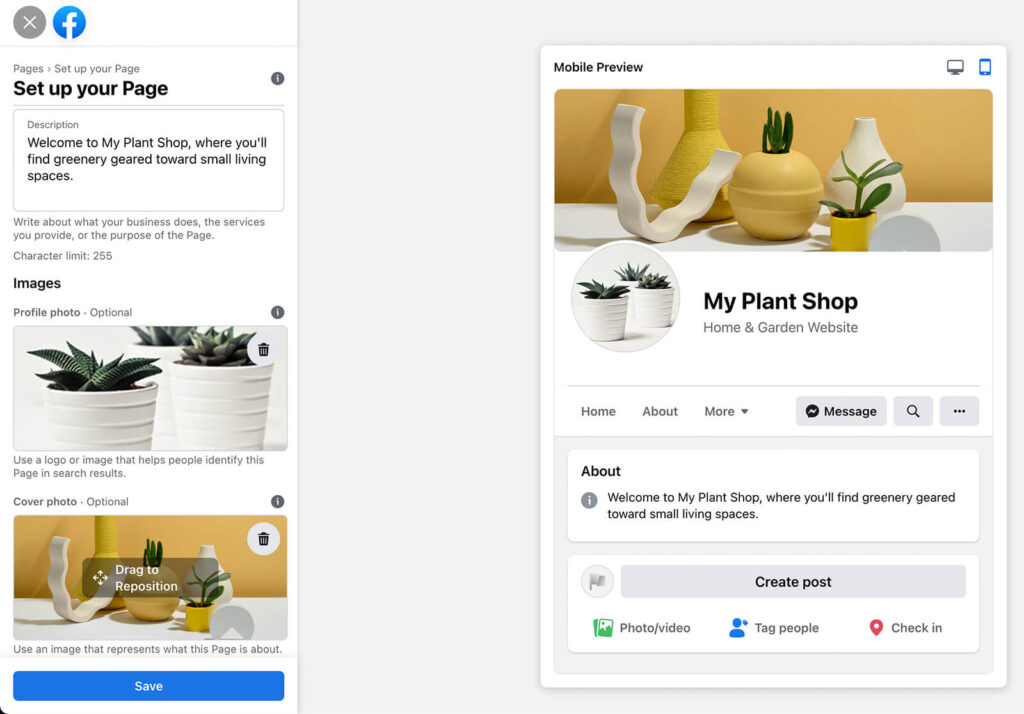



2. Recommended Ad Spend
- Weekly Spend = 50 * Cost per “Add to Cart”
- Weekly Spend = 50 * Cost per “Page View”
If you’re an info product brand, the same logic applies.
Whatever your desired conversion is, whether it is a purchase, Calendly meeting, phone call, or submitted lead form, it’s best to spend 50 * CPA per week.
If you’re looking to start running Facebook Ads or would like help optimizing ad spend, visit our Facebook Ad Agency Services page to learn more about what we offer.
Second Step to Learning How to Run Facebook Ads (Campaigns, Ads, Ad Sets)
3. Facebook Ads Campaign Types
The Facebook Campaign Structure
Facebook Ads is a three-level campaign structure. Creating and managing ads are broken down into 3 parts: campaigns, ad sets, and ads.
The first step in deciding which campaign is best for you is knowing what your objective is. It’s best to decide your objective/goal first, and then decide what type of Campaign to choose.
- Campaigns
- Where you set the objective/advertising goals. There are 13 campaign types currently.
- Awareness Goal: this is for targeting prospects who are Unaware and Problem Aware
- Brand Awareness Campaign: this is for advertisers who want people to remember their brand. There is a lack of an offer or CTA. Usually, little need for most advertisers to use this objective because you always want your ad dollars to be for ACTIONABLE EVENTS. However, if it used, it targets cold, unaware traffic most often.
- Reach Campaign: this is for advertisers who want to maximize the number of people who see their ads and how often they see them. This is most often used for audiences that are warm and aware of your business vs. cold, unaware traffic. It is strategic for Retargeting because you can effectively reach audiences where total number of people seeing the ad is more important than FB being selective who sees it. Other campaign objectives will “ignore” a portion of your audience (in order to try to get a better performance).
- Consideration Goal: this is for targeting prospects who are Problem and Solution Aware
- Traffic Campaign: Shows ads to users with the intent of moving them away from FB to your website, app in the App store, Messenger, or WhatsApp. Typically attracting cold, unaware traffic. Best suited for maximizing the number of people visiting your website at the lowest cost per visit. This campaign type is most often used by websites that derive revenue by showing ads on their website. Their revenue is based on the number of people who view pages on their website where they show ads. Most often they do not require this traffic to take any other action on the webpage.
- Post Engagement Campaign: Shows ads to users most likely to Like, comment, and share your ad. Only time you use this is to give your ad social proof – an advanced strategy would be to do this and then use that same ad with social proof in Traffic, Reach, or Conversion Campaigns.
- Page Likes Campaign: Optimizes ads for people most likely to like your Page. Helpful if you have a new page on Facebook and want to grow the Page Likes quickly. Typically want to get 100 Page likes to signal to people you’re a real business. Most often run this campaign to cold, unaware traffic **but you can also run it to people that are aware of a business to get them started Liking a new page.
- Event Response Campaign: these are to get people to respond by saying Going or Interested to events created on Facebook. The event must be active and tickets must be sold online. You will typically run this to warm, aware traffic for events that happen in a local or regional area. Common for entertainers.
- App Installs Campaign: use this to advertise your Apple or Android app on mobile devices. Optimizes for Install actions or Purchase actions using Facebook SDK, and you can allow Facebook to track everything in your app i.e. user events an actions. It is suitable for both cold and warm traffic depending on the marketing goals you have. When you setup your ad, you can specify not just what platform to advertise on, but also what versions of iOS or Android as well as the type of device like iPads. First, youll have to register your app in App dashboard on the Facebook Developers’ website.
- Video Views Campaign: Very important campaign type! Can use this type to sort and sift through cold traffic and identify people who might be interested in what you’re selling without requiring them to leave Facebook. One of the most inexpensive ways to prospect is using a video ad, casting a wide net to a cold audience since video views are cheap on FB. Using data on how much they watched your video, you can then re-engage with another ad.
- Lead Generation Campaign: A unique way to collect leads for your business without having to build a form on a web page. Can collect a lot of info on a prospect without them ever having to leave Facebook. FB will show that user a form which is prefilled with info FB already knows and the user simply clicks Next. Very low friction way to collect leads. Especially on mobile, it’s a simple and elegant way to collect leads since it doesn’t disrupt the user experience. You can use this for cold, unaware traffic or generate leads from warm traffic if promoting a new product, service, or event to people already connected to your business. First, you’ll need a Privacy Policy on your website and you’ll also need to retrieve these leads from your Facebook Page (can also automatically connect your form to your CRM so everything happens automatically)
- Messages Campaign: Will allow you to run an ad that initiates a conversation with a user through Facebook Messenger or WhatsApp. You can also show ads called Sponsored Messages inside existing Messenger conversations that users already have with your page. You can use this to connect with your most ready prospects by asking a question and inviting them to a conversation. Many questions often just need to get a simple question answered before they buy. It can also work on cold, unaware traffic but more likely to be used with warm.
- Awareness Goal: this is for targeting prospects who are Unaware and Problem Aware
- Where you set the objective/advertising goals. There are 13 campaign types currently.
- Conversion Goal: this is for targeting prospects who are Solution and Your Solution Aware
- Conversions Campaign: These allow you to optimize for an event on your website. This is why you want Facebook Pixel installed on every page. Some of the events include pageviews, content views, button clicks, leads, add to cart, initiate checkout, and purchase. You can even define custom conversion events and have your campaign optimized on those events. Most new advertisers optimize for a purchase, but those are the rarest event – FB says you should choose an event that has at least 50 conversion events a week or the Optimizer will have trouble choosing the best people to show the ads to. Recommended to create Conversion Campaigns near the top of the funnel such as View Content of Key Pages, then create Add to Cart or Lead Event ad sets, and finally create Purchase Event ad sets.
- Catalog Sales Campaign: For e-commerce stores with many products. There is a FB Feed Plugin that can connect your store if it uses a major e-commerce platform like Shopify, WooCommerce, etc. If not, you’ll have to manually export your products, format it for FB, and upload them. Main reason to use this campaign type is that you are able to use Dynamic ads that automatically pull in images and details from your catalog. A smart use of these ads is to target non-buyers who have viewed a product on your website. You can target people who have Viewed or Added to Cart but Not Purchased for 180 days. You can also upsell or cross sell specific products after purchase of a certain set of products.
- Store Traffic Campaign: Used by stores that have multiple locations. They reach people within a certain distance of each location and help a user to find or contact the store that’s closest to them. Meant to increase foot traffic in your stores. More info here: https://www.facebook.com/business/help/956093091134327?id=429905037479832
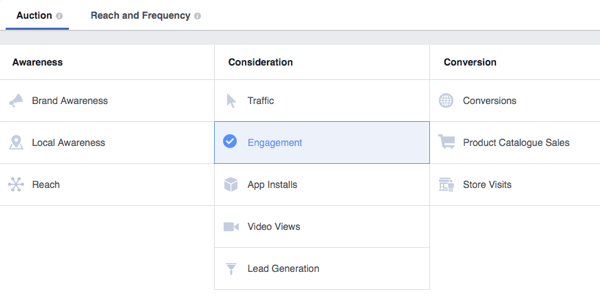
4. Facebook Budget Setting and Bidding Strategies
Budget Setting Options
- Time Period
- Daily Budget: you can specify an amount to spend each day (it’ll average out over time; some days it will spend more and others it will spend less). Use these for campaigns you intend to run for an extended time. When choosing Daily, Facebook knows it only has 24 hours to achieve your Objective. As long as you give it enough budget, it will work harder to achieve your objective but the trade-off will be the that results may not be as optimized as possible/cost efficient.
- Lifetime Budget: you can specify an amount to spend over a span of time. Use these for campaigns that will run for a specific, shorter timeframe. With this option, you can schedule ads (date, time) as the Ad Set Level. Helpful for businesses that run ads generating leads and sales during specific days and times during the week i.e. a call center that has reps only available from 9 to 5 or restaurants closed on Mondays.
- Level of Budget
- You can choose to allocate money for campaigns at the campaign level
- If you need more control over your budgets by audiences or ads, it’s better then to manage budgets at the Ad Set Level.
- Delivery Type
- Standard Option: see your budget spent equitably over 24 hours. The recommended option
- Accelerated option: budget is spent as quickly as possible.
Facebook Ad Auctions have 3 Goals
- Maintaining a wonderful user experience
- Maximizing ad revenue
- Maximizing value for advertisers
Limited ad space –> FB has a system to decide which ads from advertisers get shown to each user in their feed –> FB considers your budget and bid, ad’s quality, and ad’s expected performance which feeds into a formula they call Total Value.
Ways to Win the Ad Auction
- Have a higher CTR on your ad than Facebook expects
- Have a higher engagement on your ad than Facebook expects
- Have a higher bid
It’s all about having High CTR and Engagement on a limited budget. It’s not always about spending more money.
Choosing the Right Budget Amount
- The higher your budget, the more times you will win the auction and show ads to your target audience because you’re generating higher Total Value
- The more money spent, the less time it will take for you to know how effective ads are. You also get more traffic and more chances to sell
- Overall recommendations
- If you only have $150 to spend, spend it in a week instead of a month, to get data more quickly
- Spend a smaller amount of money on a campaign at first if trying out a new ad or audience. Then, increase to more aggressive levels when comfortable with results.
- If more than $100 daily spend, never exceed a 20% increase in budget when campaign in in Learning Mode (this lasts 24 to 72 hours – FB is testing the ad in the auction and figuring out its Total Value).
- Don’t make any changes to campaigns, ads, ad sets until a campaign is out of Learning Mode.
Campaign Bidding Strategies
With each option, there is a benefit as well as a trade-off.
- Lowest Cost: use this if you want to get the most results and volume. But you lose the ability to control costs
- Cost Cap: If you want get the most results possible while controlling the maximum amount you pay for an action like a purchase or a lead. But you may sacrifice volume if benchmark CPA too low
- Target Cost: use if you want to average out your CPA over time. But you will lose some volume and lower cost results.
- Bid Cap: if you want to control costs at the bid level. You will lose control of CPA, but still control overall cost and get more volume than Cost Cap and Target Cost.
- Recommended Option: use the Lowest Cost method for most campaigns until you start to understand CPA that you’re tracking and what you are willing to tolerate to make the numbers work.
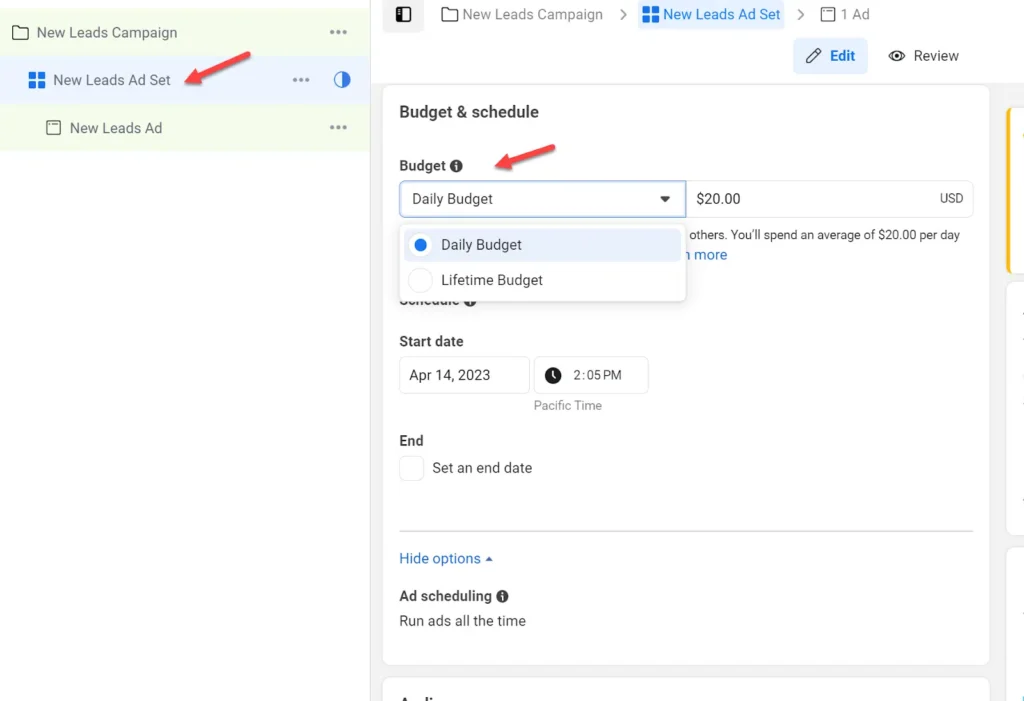
5. Facebook Ad Sets Best Practices
- Ad Sets
- Where you define your audience (who can see your ads) and placement (what part of the Facebook platform to show your ads on)
**Never start advertising to cold and unaware traffic. Starting point for first campaign should be traffic that has some kind of previous relationship with you (Solution Aware or Your Solution Aware).
Work way down the list and start at the point when you can say “Yes” to one of the audiences:
- Customer List
- Collecting emails / phone numbers of customers – upload this list and create a Custom Audience
- You’ll need an offer. Don’t use your main offer since many of the people on the list will already have purchased it
- Some ideas are a flash sale or holiday sale
- If you don’t want to discount, then create a unique bundle or product that is desirable to your existing customers
- Great idea to advertise to current customers first because they’re most likely to buy from you again
- Use this revenue to fund ads while learning Facebook Ads
- Prospect List
- If you don’t have a list of paying customers, but you have a list of phone numbers or emails for prospects, this is the next best option
- Upload Prospect List to create a Custom Audience
- Once your list is uploaded, you can use your main offer or one of your lower-priced offers since these are easier to sell
- Traffic going to the site from another source or inside a mobile app
- Advertise directly to visitors if you get a lot of organic traffic or traffic from other paid sources
- Create a custom audience on all website visitors – segment them based on their last visit to your site. Someone who visited yesterday is more attentive than someone who visited 30 days ago.
- If there’s no traffic or lists
- Start with cold traffic and use Facebook Ads to create traffic and prospect lists – this is the most difficult way to start
- Tell FB as much as you can about your ideal customer and run a Traffic Campaign (can only target based on demographics, interests, and behaviors)
- Try to generate leads or sell a low-priced product in the $7 or $49 range
- Once the campaign is running, you can retarget the website traffic, leads, and buyers in one of the three other methods
How Ad Sets Fit into Your Facebook Ad Campaign
- This is one level below campaigns. Where you’ll deploy your audiences along with other useful filters; where you define WHO sees your ad
- Not uncommon to have hundreds of Ad Sets per Campaign, but majority of new advertisers will start out with a single Ad Set under your Campaign
- This is where you decide where your ad is placed, when it will be seen, who will see the ad, and how your ad will be optimized for exposure and cost. This is where you can gain competitive advantage over other businesses
- If you want to test various aspects of creative, toggle Dynamic Creative to On
- Align the ads with the proper Facebook/Instagram Business Page or app
- For lifetime budget, leave the current time to start. If you do change the end date, change the budget as well or it can throw off the Optimizer (total budget / number of days) * however many days you’re adding or subtracting
- You can also set spending limits per ad group inside Budget & Schedule section of the ad set. May not reach the maximum or minimum if you don’t have enough traffic. Campaign Budget Optimization will direct the most impressions to the ad sets performing best on the campaign objective, which is OK in most circumstances, but if you need or desire a more equitable share of impressions to all Ad Sets, then set ad spending limits
- Choose Target Audience by clicking Custom Audiences and choosing one. You don’t have to but they can be an extremely powerful method of targeting. You can do any of the created Custom Audiences, a Lookalike, or exclude audiences as well. You can also narrow down a targeted audience by choosing a location such as country, region, state, cities, ZIP, postal code. If you select an area to pin, you can do a 1-mile radius (this is microtargeting and can be effective at tradeshows, etc.) to a 50 mile radius. You have the choice to target:
- Everyone in the location
- People that live in the location
- People recently in the location
- People traveling to the location (from more than 125 miles away)
- Generally a good idea to narrow age range to at least exclude minors if your product isn’t for them and also to dial in your age range if you know your typical customer age range
- Generally will leave gender set to both (unless you sell women’s products or men’s products). Unnecessary when targeting a Lookalike Audience because if your model has a gender bias, so will the lookalike audience
- Normally leave the language field blank – **don’t need to choose English if in a English-speaking locale. But if you want to reach Spanish speaking people in the USA, then choose Spanish and produce your creative in that language
- Automatic Placements is the default, and do not use it when starting out
- Exclusions and Block Lists: available for ads in the Audience Network, Instant Articles, and In-stream Videos placements
- Limited: won’t show ads with content that shows tragedy, conflict, debated social issues, objectionable activity, sexual or suggestive, strong language, explicit content, adult apps like alcohol delivery, streaming, dating, news, gaming, weather, travel, food and drink apps. It’s very strict
- Standard (default): won’t show ads with content that shows tragedy, conflict, social issues with direct attacks or strong language, drugs, nudity, alcohol delivery, violence, some uses of strong language, games that focus on war, drugs, or alcohol.
- Full inventory is all the content. Still won’t show where there are direct attacks on protected characteristics like race or religion, the sale or use of any drugs, nudity, and excessively violent content
- The list of publishers is in Assets Library, Brand Safety, Block Lists. Can choose which ones to block proactively. Brand Safety has a report where ads showed so that you can block sites reactively
Using Detailed Targeting
- This uses demographics, interests, and behaviors that FB knows about its users. If prospecting, you should try to use a Lookalike Audience first because FB’s AI is better at matching people than Detailed Targeting in almost all cases
- Demographics
- Education, financial, life events, parents, relationship, and work
- Interest
- Business and Industry, entertainment, family and relationships, fitness and wellness, food and drink, hobbies and activities, shopping and fashion, sports and outdoors, technology
- Behaviors
- Has to do with actions people take on Facebook like using FB Payments, clicking on a shop now button on an ad, post interactions, expressing interest in an event, etc.
- As you add targets to your list, your audience grows. This is an OR Boolean such I want to target married people OR parents. For the AND Boolean, which is targeting married parents, use the Narrow By/Must Match feature (still not as powerful as a Lookalike, but helpful for getting started if you don’t have the ability to create one or you’re doing Audience layering)
Targeting Facebook Connections
- Useful for getting Business page likes over 100 or prospecting to friends of connections (people who like your page or friends of those people, people who have used your app or their friends, and people who have responded to your events)
- Don’t use for anything else
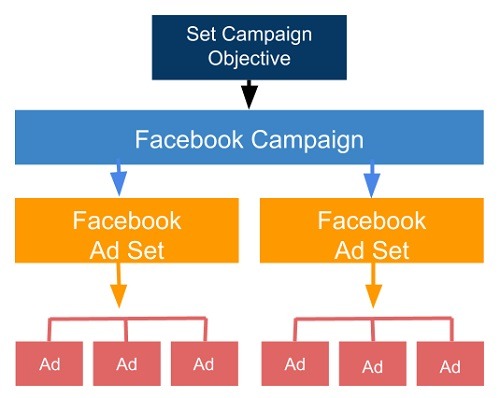
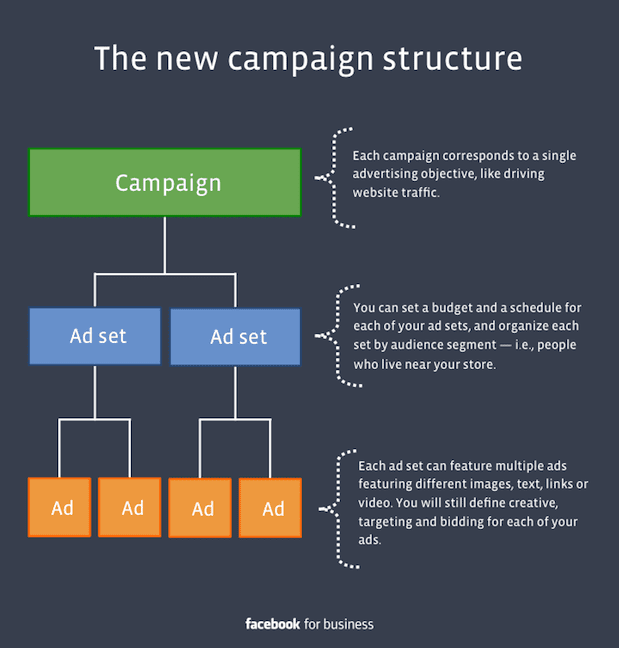
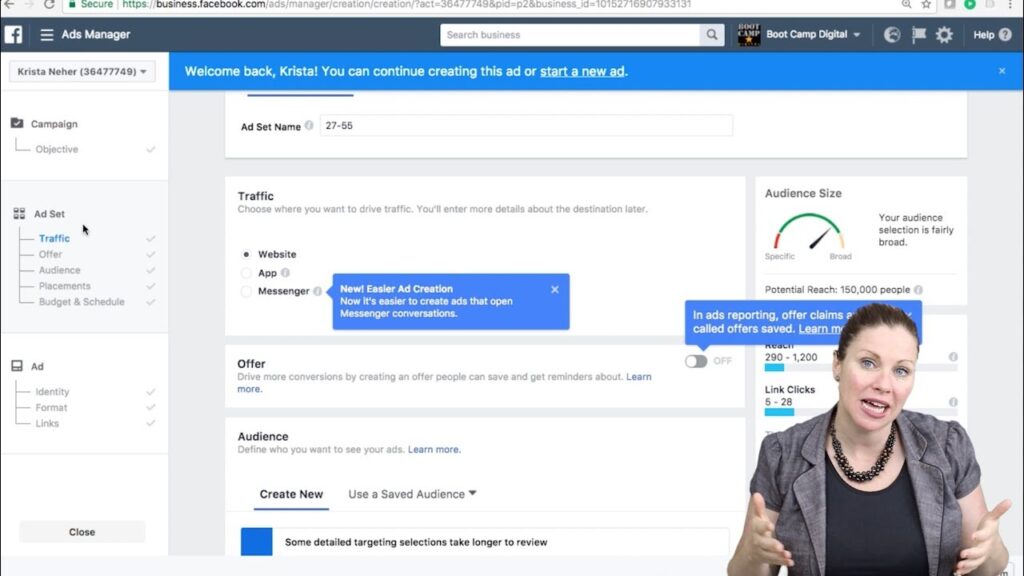
6. Facebook Ads Best Practices
- Ads
- Where you produce your creative
The Elements of An Ad
- Imagery or the first second of the video has to catch user’s attention. The visual is the most important part on FB!
- Headline is in bold at the bottom; should be between 4 and 6 words and sum up the ad. Try not to repeat what’s in the body text
- Call to Action button (Learn More) is also at the bottom and will also appear at the conclusion of a video. Match your CTA to the action you need the user to take
- Image and video thumbnails have to be less than 20% text or FB will severely decrease the number of impressions of your ad. Once the video starts, it can have as much text as you want (another reason to use video vs. images if you need to use a lot of text). You can possibly submit for a manual review if you believe they are incorrectly penalizing you.
- It is extremely important to use multiple ads per ad set. Allows you to test multiple creatives to see what best resonates with your audience (two to six ads per ad set is best practice – **note that this is different than split testing). FB determines which ads are the best at generating responses at the best cost and give those the most impressions
- Since imagery is the most important element in generating response, test imagery first
- Try to test only one parameter at a time so that you can isolate what’s working vs. what’s not
- Then once you have a winning image or two, try different headlines or CTAs
Choices of Visual Media
- Video consistently outperforms still images a majority of the time; also allows you to build a “Video Viewers” audience where you can advertise to people who simply watched your video without clicking on anything
- FB makes it easy to create eye-catching video even for users with no experience
- FB chooses thumbnail but we can also select if we want to. In most cases, it’s better to let them automatically test different ones so they can find the one that leads to the most video views
- 85% of videos on FB are played without sound so it’s a good idea to turn on captioning
- For the Facebook Desktop, we recommend 16:9 (Landscape) format
- For Facebook Mobile, we recommend 1:1 (Square) or 9:16 or 4:5 (Vertical) to take up real estate, but we often still used 16:9 (Landscape)
- For Instagram, use 1:1 (Square)
- For Stories (FB and IG) use 9:16 (Vertical)
- “Thumb-Stopping Content” is crucial
- Visuals of happy often work well because it’s what people expect when scrolling through their feed, but it isn’t enough
- Add something unusual to catch their attention. Gestures and words also make for interesting images. Or have a client with a blurry background (not a stock photo). Or present a product in an unusual way. Can even include emojis in the ad text.
Ad Formats
- Single image or video, which includes a video slideshow of multiple still images
- A Carousel of two or more horizontally scrollable images or videos
- Collection format that opens a group of items into a full-screen experience. There are 4 different templates
- Instant Storefront: display a catalog in a grid with one main product at the top
- Lookbook: people see the products in action or imitate a product catalog
- Customer Acquisition: useful for driving people to a landing page and having multiple images/videos that show off your single odder
- Instant Storytelling: helps tell a story of the product or business
- When creating the first ad, it’s fine to start with single-image format or the Carousel with several images if trying to tell a deeper story
Up-to-date Best Practices of Image and Video Formatting Across Different Social Media Platforms: https://sproutsocial.com/insights/social-media-image-sizes-guide/
Primary Text: on mobile News Feed Ads, three lines of text show before the “See More” button. If doing bullets, replace the bullets with related emojis (they usually work better)
Call to Action: make the button as clear as possible with what you expect them to do and this will get you higher conversions.
Instant Experiences
- They load instantly in the Facebook app when the ad is clicked on; they are like a mini landing page within FB instead of the website. It’s mobile-optimized and full screen
- Can watch multiple photos and videos, swipe through carousels, even tile and pan an image all within the ad
- Collections Ads always lead to Instant Experience
- Can also add an Instant Experience to a Carousel Ad or Single Image or Video Ad. You can customize it with building blocks – header is a logo at 882 x 66 pixels or titling the experience with text, video should have captions and be under 2 minutes, photo should have a width of 1080 pixels and can link to a website, app store, or other IE, text block will let you tell your story or describe a picture/video/product, a carousel holds 2 to 10 images, all of which can link to a website, app store, or other IE, button will take someone to a website, app store, or IE). You can chain IE together to create a multiple landing page experience all without the customer leaving FB
- Customer Acquisition
- Story Telling
- Selling Products without a Catalog
- Augmented Reality Experience
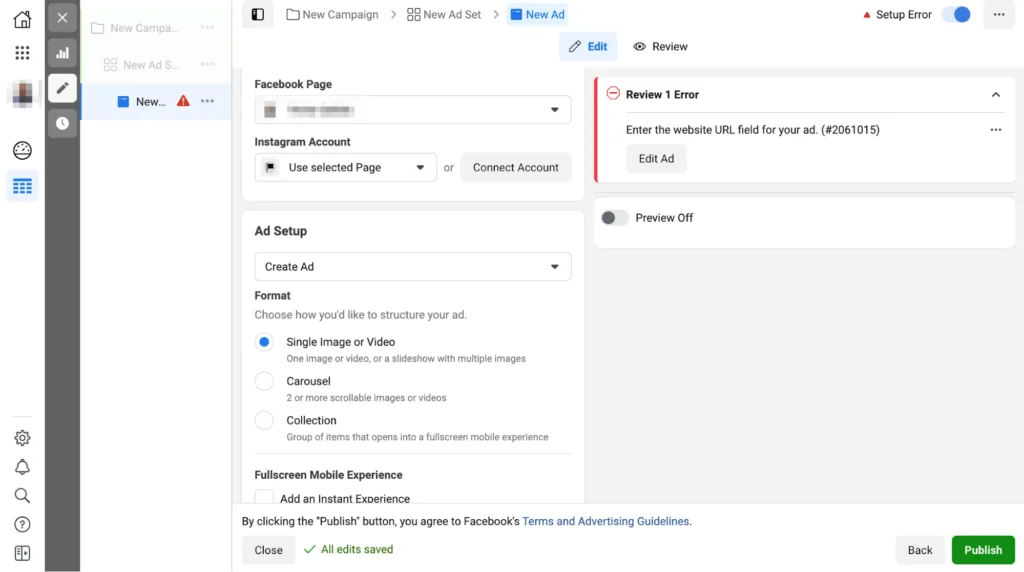
Third Step in Learning How to Run Facebook Ads – Creatives & Story
7. Creative Best Practices
The creative, other than targeting, is probably one of the most overlooked aspects of your campaign.
Big Magic: Creative Magic Beyond Fear by Elizabeth Gilbert (2015) is a great book for this. It teaches you how creative comes to you specifically.
You can also get inspiration from Facebook’s Creative Hub here.
A new addition called Instant Experiences is also here.
Six Creative Must-Haves (all of them don’t have to exist in every creative, but #1 definitely does):
- Your creative should be reflective of your hook
- The offer is whatever you’re trying to get the customer to do (buy a product, download something, etc.)
- The hook is the way you market and sell your offer; one offer can have ten hooks if you’re testing 10 different marketing messages to get someone to take action
- Tell a story about how your offer can change or affect their life. Carousel ads are a great way to do this
- Display the product if it is a physical product or something you can literally demonstrate. This especially affects further down the funnel
- Stand out in the news feed
- Use contrasting colors because this catches people’s attention
- Little video ads or gifs, because they move, can also accomplish this
- Convey the marketing message while making it a little bit flashy
- Be on brand
- Make sure that your images have something that really stands out and it’s the same across all the images
- The more campaigns you run, the more people are going to start recognizing your brand – so ensure there are similarities; this will be good for brand lift
- Play off emotions already associated with an image
- Figure out what associations people already have in common that you can play off
- What icons or images do people have a relationship with already?
- An example is an image of a low battery icon if you are selling chargers
What Not To Do – an image or video that has nothing to do with the hook or offer. It will be terrible for your brand and lead to a lot of unqualified clicks.
8. Crafting a Story
Developing your story helps visitors see you’re not boring and believe that your business is different. There are two choices to get more sales through advertising:
1. Spend More Money
2. Add more depth to your brand’s story to stand out***
- The more you connect with people, the more they will buy your product. People love to be connected to people who share the same slices of life with them. It makes it simple for you to connect with your audience.
- They make you immune to competition. People will knock off your product, but they can’t knock off your story.
- FB is the perfect platform where you can develop an entire lifestyle or personal brand and truly build a following: who you are, why you do what you do, and why you created the product is really important
- Be willing to be vulnerable and go deep. That leads to the most success.
- Not nailing your story will give you poor results
- Start with the part of the story that’s important to your customers when meeting them for the first time. It gets their mind focused on the reason that a product or service exists. How it benefits the marketplace and users, not just utility.
- Then once you have their interest, go into more detail with story to keep them interested.
- People don’t like to be sold to, but enjoy buying from people they like. Smart business owners take charge of the conversation and be the one people want to do business with
- Sometimes people don’t buy from you because you’re the cheapest; but because you’re the most personable
Why Questions to Answer
- Why do I do what I do?
- Why did I get into this business?
- Why do customers love doing business with me?
- Why can our products and services change lives?
What Questions to Answer
- What’s my background?
- What is my superpower? (if you don’t know, send an email to 5 to 10 of your closest friends and ask what your biggest strengths are)
- What’s the best story behind my product or service?
- What problem does my product and service really solve?
- What does it do better than any other product?
Who Questions to Answer
- Who is my customer—what are their burning needs and desires?
- Who has had success or transformation because of my products or services?
- Who can give me testimonials and reviews to establish my credibility?
- Who has published stories about me in print or online I can talk about or reference?
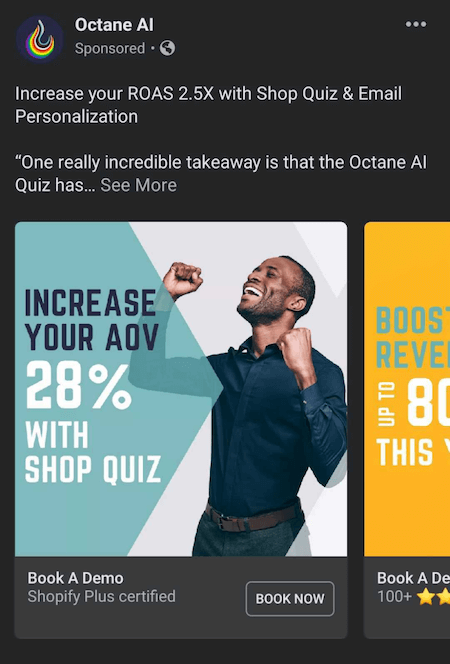
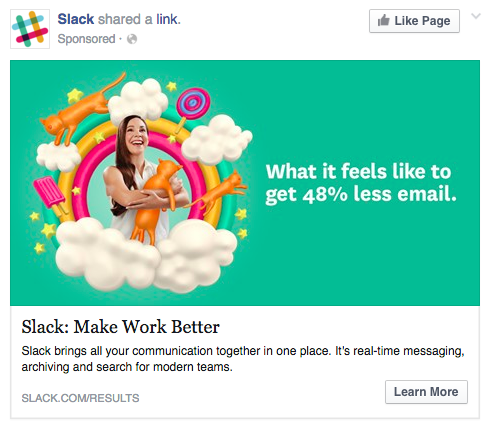
Fourth Step in Learning How to Run Facebook Ads – Audiences
9. Audience Targeting
Facebook’s Four Types of Audience Targeting
- Custom Audiences
- Created by a user’s activity both on and off Facebook
- Demographics
- Includes age, gender, language, and location
- Detailed Targeting
- Additional Facebook demographics, interests, and behaviors
- Connections
- Connections of people who like your page, event, or app and their friends
**The biggest mistake new advertisers do is jump right to targeting cold audiences. This is the correct targeting hierarchy (priority) for using Audiences:
- Customers Using Custom Audiences
- Unconverted Leads/Prospects using a Custom Audience
- Engagements using a custom audience
- Compiled lists using a custom audience
- Lookalikes
- Interest or detailed targeting
10. Retargeting Campaigns
The structure of a Retargeting Campaign:
- Create an audience of everyone who visited the landing page from both your initial prospecting ad and other traffic sources such as Google Ads
- Exclude the audience of people who have already visited the page that you ultimately want to send them to – whether it’s a new program or service. If they’ve already seen the page, don’t pay to send them there again
- Create a Reach Campaign to show the ads to as many people that viewed the original landing page as possible. They were originally driven there by a Traffic Campaign so it is proven that they will click on the ads. If you have over 1,000 people in the audience of people in the 7-day period, optimize for Traffic or Conversion rather than Reach. Do traffic if you don’t have a specific offer or action they take on the page. Do conversion when you have a measurable action they can take.
- Also exclude people who are existing customers of a product
- Apply the same geography and age restrictions as the prospecting ad, since not all of the page’s traffic comes from Facebook Ads
- Only do placements in Facebook and Instagram for now. FB news feed and IG news feed, These are still the best-performing placements. Get an understanding of how everything works before moving onto less-performing ones.
- Define a frequency cap for the Reach campaign. The more urgently you want someone to see your ad, the more impressions you want to show each day. Recommended a frequency cap of two impressions per day for this audience of landing page visitors within the last 7 days
- You can use some copy from the new landing page to use as part of the ad. This is efficient and helps the ad and the landing page’s message match.
- Publish your changes
You can also retarget people who don’t visit your landing page but show serious engagement with a video ad by watching it most of the way through.
- Create a second ad set inside the Retargeting Campaign
- Call it 7 Day Prospecting Video Viewers 75%
- Create 2 new audiences for this ad set
- The first one is 7 Day Prospecting Video Viewers 75%, with Video as the Source, and people viewing at least 75% of the prospecting video from the ad in the last 7 days
- The second one is Three Second Viewers Caregiver Retargeting
- Move this one to the Exclusion list*** to prevent this Retargeting Ad to someone who watched 3 seconds of the video and took no action
- You don’t want to waste money on people not interested in our content
- Apply demographic restrictions and choose News Feed placements
- Exlude audience of current customers of the product, people who visited the landing page and filled out lead form within 7 days, and 3 second Viewers
- Frequency cap of one impression per day, since this audience is less engaged than the other retargeting ad set
- Can use the same ad as you did for the landing page visitors by finding the ad in the Ads Manager and then clicking the Duplicate Button > Existing Campaign > Unselect existing ad group of landing page visitors and choose the video viewers > publish changes
You can also use Retargeting to get Facebook Lead Forms completed. This is for people who opened your Lead Forms, and did not submit, most likely because they forgot. You create the audience as in the screenshot below. Send these people to another ad that asks them to fill out the lead form and/or list additional benefits of filling the lead form out.
Also use Retargeting FOR RECENT BUYERS, since they’re the most likely to buy from you again. Use your Thank You or Order Complete page and target recent buyers with an upsell or cross-sell campaign. Set up would be the same but the source audience would be visitors to the post-sale page.
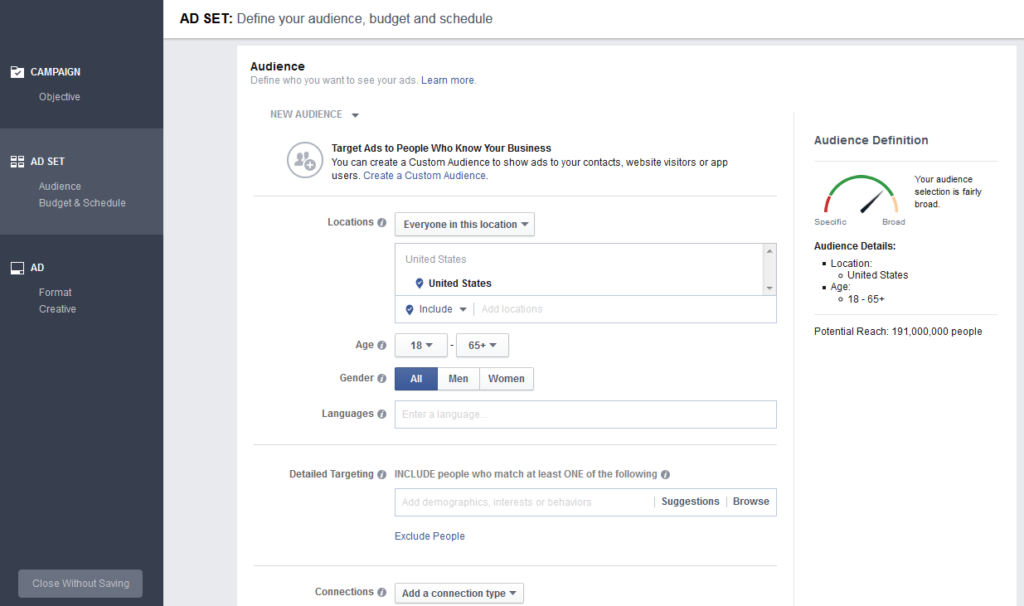
Fifth Step in Learning How to Run Facebook Ads – Placements
11. Facebook Placements
Placements: remember to customize the creative for each one. There are tools inside of Ad Manager to help do this, but there is no reason to spend hours customizing creative for every Placement on a new campaign.
Test it on one Placement, measure the response, and when satisfied with the results, then “scale” the campaign by expanding to other Placements.
Here’s Facebook’s official article on Placements as well.
- Facebook News Feed
- These ads appear along with posts from friends and pages
- One of the best formats is the vertical (9:16) videos. They take up more screen space as people scroll by and the time limit is 4 hours!
- Instagram Feed
- These ads appear along with posts from friends and interrupt the normal feed scroll
- One of the best formats is the square (1:1) videos. Time limit is 2 minutes
- Facebook Marketplace Placements
- Marketplace Ads appear within the listings on the desktop homepage or in the mobile app in Marketplace
- Best format is the vertical 9:16 videos – so you can reuse News Feed videos
- Ads in Marketplace will also show in News Feed. It’s not currently possible for an ad to show only in the Marketplace
- Facebook Video Feeds Placement
- Appear in the Suggested Videos section when someone is watching another video, as well as the Facebook watch feed
- Best format is the vertical (9:16) videos. Time limit is 4 hours!
- These are not the same ads that interrupt other videos. They show up in the list of videos to be watched
- Facebook Right Column Placement
- A quickly dying ad placement
- Image-only on the right-hand side of the News Feed on desktop browsers only, which is a detriment to impressions because most people use their phones
- JPG or PNG
- Landscape (16:9) is the best and resolution should be at least 2292 x 1200 pixels
- Only available for Traffic, Conversion, and Catalog Sales
- Messenger Inbox Placement
- These ads appear between conversations
- Condensed at first and then when clicked on, it shows the full ad on Messenger
- Best format is 1:! Square image
- Stories Placement
- Photos show for 6 seconds and videos show for up to 15 seconds
- If someone interacts with your video, it can be up to 2 minutes long
- Video should be vertical (9:16)
- When designing creative, keep any text and logos out of the top and bottom 15 percent (250 pixels or do) because it might be covered by profile icon or CTA button
- Definitely preview these ads before adding them
- Messenger Stories
- These ads only show up when someone looks at their stories from inside the Messenger app
- Basically extends the reach of FB stories and IG Stories ads
- Facebook Search Placements
- These ads appear mixed in with the general Search function and Marketplace search
- Unclear how effective these are because it is a relatively new placement
- Messenger Sponsored Messages
- Inside the Messenger inbox to re-engage people who already have an existing conversation with you
- Runs by itself and will turn off all the other placements
- Only images are supported; best image size to use is 1200 x 628 pixels to fill the width of the Messenger screen
- Facecbook Instant Articles
- Fast, interactive versions of an article inside FB’s mobile app that also appear on a publisher’s website; usually has a lightning bolt icon under the main image
- Load up to 10x faster than standard web pages, contributing to a 20% increase in articles that are read compared to offsite links and 70% decrease in people abandoning the article
- Format the video to be portrait 9:16
- Audience Network
- This is where you can run ads on websites and apps and reach people when they’re off FB and Instagram. When they click the ad, it opens up:
- A link in a new browser window
- Ask to install an app
- This is where you can run ads on websites and apps and reach people when they’re off FB and Instagram. When they click the ad, it opens up:
- Launch an existing app
- 1 billion people a month see an Audience Network ad each month and this is growing
- Running in a 1/3 of the top 500 Android Apps
- You can explicitly set the look and feel of the ad to look like the content of the site or app. FB will take your creative and format it to match the site. These are called native ads
- There are various types of formats
- Banner ads (images) which have three sizes. Standard Banner which is 320X50 pixels and the best for phones. Large Banners 320×90 pixels are the best for tablets for XL phones. Medium Rectangle 320×250 pixels are the best for scrollable phones
- Interstitial ads take up the full screen and can be a video or an image. Should be a vertical format (9:16) and videos can be up to two minutes long
- Audience Network Rewarded video ads are full-screen ads that users opt-in to view inside an app. In exchange for watching it, they get something of value inside the app like virtual currency or exclusive content. The video is non-skippable between 3 and 60 seconds. It has a CTA button at the end. Make the video landscape 16:9 if it’s a game app – most games are played in this landscape. If your audience mostly uses apps in portrait mode, then make the video in portrait mode (9:16).
- In-stream video placements interrupt a person watching a video either on or off Facebook. Video has to have sound and should be widescreen (16:9) format.
- Facebook In-stream Video Placements: 5 to 15 second videos that interrupt someone viewing a video on FB in the middle of the video
- Audience Network In-Steam Video Placements: 5 second to 2 minute videos that interrupt a video off Facebook in the middle of another video or game
